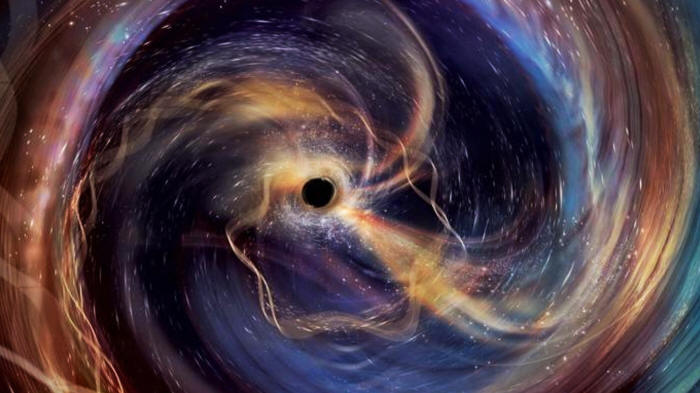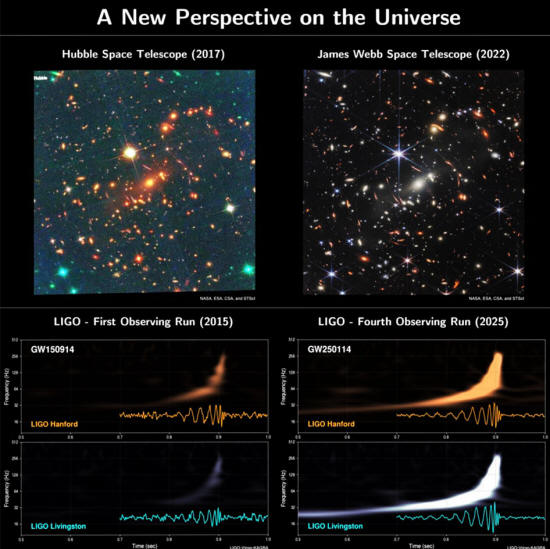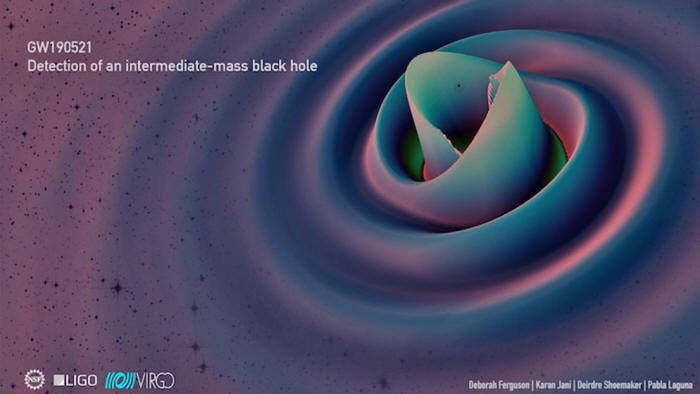|
by Robert Lea a powerful collision between two black holes that created gravitational waves observed by LIGO, as seen from one of the black holes involved. (Image credit: Aurore Simonnet (SSU/EdEon)
LVK/URI) is the loudest gravitational wave event we have detected to date; it was like a whisper becoming a shout."
LIGO achieved this latest milestone by detecting gravitational waves, or tiny ripples in spacetime.
In just four days, on September 14, LIGO will celebrate exactly 10 years since it made the very first detection of gravitational waves.
Its detection represented an entirely new method of astronomy - a way to "hear" spacetime ringing after some of the most powerful events in the cosmos rather than "see" them by relying on electromagnetic radiation.
Since then, LIGO and its gravitational wave detecting partners, Virgo and the Kamioka Gravitational Wave Detector (KAGRA), have detected a multitude of gravitational wave signals from other black hole collisions, mergers between neutron stars, and even from two rare "mixed mergers" involving a neutron star and a black hole.
Video...
Black hole theories validated by new gravitational wave signal
This newly detected signal, GW250114, stands among previous detections as one of the clearest gravitational wave signals ever.
Hawking's prediction involves the light-trapping outer boundary of a black hole called the event horizon.
This marks the point at which the gravitational influence of the black hole becomes so great that not even light moves fast enough to escape its grip.
As gravity is related to mass, the size of an event horizon, also known as the Schwarzschild radius - after Karl Schwarzschild, the first physicist to solve the equations of general relativity and inadvertently predict the existence of black holes - also depends on the mass of a black hole.
The greater the mass, the wider the event horizon.
In 1971, Hawking, along with physicist Jacob Bekenstein, predicted that when black holes merge, the total area of the resultant daughter black hole's event horizon would be larger than the area of the progenitor black holes' event horizons combined.
The duo said that event horizon would have an area proportional to its level of disorder or "entropy."
GW250114 revealed that the progenitor black holes had a total surface area of around 93,000 square miles (240,000 square kilometers), which is around the size of the entire U.K.
The daughter black hole created by the merger, however, has a surface area of 154,000 square miles (400,000 square kilometers), which is about the size of Sweden.
Infographic showcasing the advancements of gravitational wave observatories - among the most precise measuring machines ever built by humankind, in observing black hole cosmic collisions, with the registered signals shown in the bottom panel. (Image credit: Dr. Derek Davis (Caltech, LIGO Laboratory).)
Another prediction verified by this research comes from New Zealand mathematician Roy Kerr, who developed Kerr geometry from general relativity, which describes empty spacetime around a rotating black hole, or a Kerr black hole.
Following mergers between black holes, these systems enter what scientists call a ringdown phase.
This sees the daughter black hole vibrating and emitting gravitational waves at very specific frequencies, akin to the changing "voice" of the black hole.
Kerr predicted the "voice" of the black hole could be described by two values alone:
This really sets black holes apart from other celestial objects, like stars, that must be described using a vast range of characteristics.
What is extraordinary about this is the fact that a black hole 1 billion times as massive as the sun can be completely characterized by just two numbers:
A simulation of the black hole merger event showing the chirp at the merger point which is followed by a ringdown. (Image credit: LIGO/Virgo)
What is fitting about this new detection is the fact it is so similar to the signal that LIGO detected to make history on September 14, 2015, GW150914.
Regular and purposeful improvements have been a constant factor in the life of LIGO, which consists of two detectors in Washington and Louisiana that can now measure distortions in spacetime that are 1/10,000 the width of a proton, or 700 trillion times smaller than the width of a human hair.
...Kip Thorne, an expert on the theory of black holes who won the 2017 Nobel Prize in Physics with Weiss and Barry Barish for the development of LIGO, said in a separate statement.
Who could have predicted this technology could have been so successful in opening a new window to our study of the universe?
Certainly not Einstein, who, when he theorized the existence of gravitational waves, predicted that no instrument of Earth would ever be sensitive enough to detect these spacetime ripples.
Future improvements for LIGO could include the addition of a planned fourth detector, this time located in India, which will improve the precision with which LIGO-Virgo-KAGRA can localize gravitational wave sources.
As for this latest milestone, it is certain that Einstein, Hawking and Weiss, the latter of whom passed away just last month, would all have been thrilled to see LIGO further validate their work.
The team's research (GW250114 - Testing Hawking's Area Law and the Kerr Nature of Black Holes) was published on Wednesday (Sept. 10) in the journal Physical Review Letters...
|





